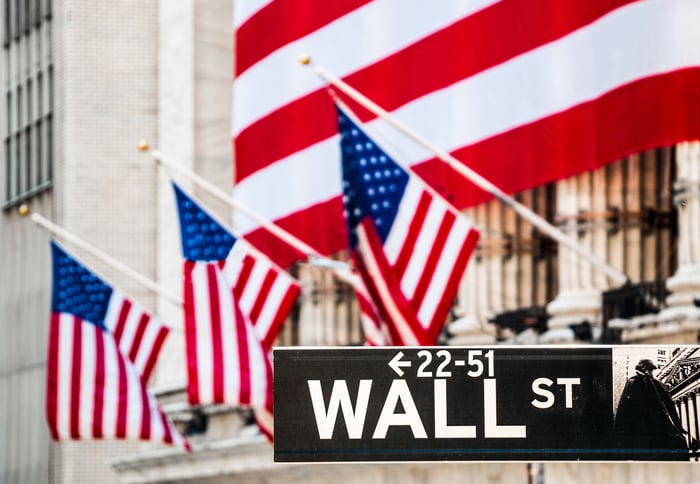Although the stock market has been volatile of late, patience has time and again paid off handsomely for Wall Street and investors.
Last year, the iconic Dow Jones Industrial Average (^DJI 0.38%) catapulted higher by 19%, effectively doubling the index from its pandemic intra-day low that was set in March 2020. It's one heck of a bounce for an index comprised of 30 mature multinational companies.
Great deals can still be found, even with the 125-year-old index within a stone's throw of an all-time high. As we steam ahead into 2022, the following four Dow stocks stand out as screaming buys.

Image source: Getty Images.
Salesforce
Though the Dow Jones Industrial Average is known for mature value stocks, the fastest-growing Dow component, Salesforce.com (CRM -0.75%), looks like a surefire buy following its recent pullback.
Salesforce is a cloud-based customer relationship management (CRM) solutions provider. In English, this means it provides software solutions that help consumer-facing businesses build on existing customer relationships and grow their sales. CRM software can handle basic tasks, such as looking up client data and overseeing customer service issues, to more complex tasks like handling online marketing campaigns and running predictive sales analyses for new products or services. While the service industry is the most logical end-user of CRM software, it's finding plenty of usage in the healthcare, financial, and industrial sectors, as well.
Salesforce is the undisputed dominant player in CRM software solutions. According to a recent report from IDC, Salesforce accounted for 23.9% of global CRM spending in the first half of 2021. Comparatively, the companies listed at No. 2 through 5 in share, Oracle, Microsoft, SAP, and Adobe, added up to just 19.4% market share in the first half of last year. That's how far ahead of the curve Salesforce is from its competition.
While organic product development has been important, one of the keys to Salesforce's success has been its inorganic expansion. CEO Marc Benioff has overseen the acquisitions of MuleSoft, Tableau, and most recently, Slack Technologies. These buyouts expand the company's ecosystem, broaden its customer reach to small- and medium-sized businesses, and give it the opportunity to cross-sell its products.
Benioff aims to more than double the company's sales to $50 billion by fiscal 2026 (Salesforce recorded $21.3 billion in full-year sales in fiscal 2021). If growth remains on track, Salesforce could reasonably become a trillion-dollar company within the next 15 years.

Image source: Getty Images.
Walgreens Boots Alliance
If deep-discount value stocks are more your forte (how does a forward-year price-to-earnings ratio of 10 sound?), pharmacy chain Walgreens Boots Alliance (WBA -0.06%) has the look of a screaming buy in 2022.
Typically, healthcare stocks aren't impacted much, if at all, by recessions. Since we don't get to choose when we get sick or what ailment(s) we develop, the demand for prescription drugs, medical devices, and healthcare services is little changed. But this wasn't the case for Walgreens, which was hit hard by the pandemic. Since pharmacy chains rely on foot traffic for front-end sales and clinic revenue, Walgreens took it on the chin during the initial stages of the pandemic lockdowns.
The good news for investors is that this pain is temporary. The company is working on a multipoint turnaround strategy that's well underway and should begin paying dividends this year.
For instance, management understands the push-pull dynamics of expensing in a highly competitive industry. The plan was to eliminate $2 billion in annual operating expenses by the end of fiscal 2022. However, management reported that Walgreens achieved more than $2 billion in annual cost savings a year ahead of schedule.
At the same time, the company is spending aggressively on digitization initiatives designed to drive direct-to-consumer sales. Even though its brick-and-mortar locations are still its key revenue driver, e-commerce represents a sustainable double-digit growth opportunity.
But the most exciting aspect of Walgreens' turnaround strategy is its partnership (and investment in) VillageMD. The duo plan to open over 600 co-located health clinics in more than 30 U.S. markets by 2025. The differentiating factor here is that these are full-service, physician-staffed clinics. The expectation is for these clinics to drive repeat business directly to Walgreens' pharmacy.

Image source: Getty Images.
Merck
Another Dow stock value investors can gobble up in 2022 from the healthcare space is pharmaceutical company Merck (MRK -0.38%).
Big Pharma Merck has received a lot of attention for its work on an oral COVID-19 antiviral pill designed to reduce the risk of hospitalization or death in patients experiencing COVID-19 symptoms. In my view, Merck doesn't need any sales assistance from COVID-19 therapeutics for its shares to head higher this year and over the long run.
The steadiest catalyst for Merck continues to be cancer immunotherapy Keytruda. Merck's lead drug has a laundry list of approved cancer indications in the U.S. and delivered an astonishing $4.53 billion in third-quarter sales (21% year-over-year growth, excluding currency fluctuations). If not for COVID-19 vaccines, Keytruda's more than $18 billion in annual run-rate revenue would make it the second best-selling drug in the world. With additional clinical trials ongoing, label expansion opportunities and pricing power should yield sustained sales growth.
Like Salesforce, Merck will lean on acquisitions to do some heavy lifting from time to time. In mid-November, the company completed its acquisition of Acceleron Pharma for $11.5 billion in equity value. This deal brought late-stage drug sotatercept into the fold. Sotatercept is targeted as an add-on therapy for patients with pulmonary arterial hypertension and is expected to eventually top $1 billion in annual sales if approved by the U.S. Food and Drug Administration.
Additionally, investors shouldn't overlook Merck's fast-growing animal health segment. While both its livestock and companion animal divisions have delivered double-digit sales growth, it's the companion animal segment that offers the greatest long-term upside. Pet owners have demonstrated they're more than willing to open their wallets to ensure the well-being of their furry family members.

Image source: Getty Images.
Visa
A final Dow stock that's a screaming buy in 2022 is payment-processing giant Visa (V -0.14%).
One of Visa's best attributes is that it's a cyclical company. This means it performs well when the U.S. and global economy are firing on all cylinders, and it tends to struggle when recessions rear their head (i.e., consumers and businesses clamp down on their spending). Although recessions and contractions are inevitable, they usually only last a few months to a couple of quarters. Comparatively, periods of economic expansion typically last years. Visa is the perfect stock for patient investors who want to play a simple numbers game.
It also doesn't hurt that Visa holds the lion's share of credit card network purchase volume in the U.S., the world's leading market for consumption. In 2018, Visa's share stood at 53% and was over 30 percentage points higher than the next-closest competitor. Further, its share of credit card network purchase volume expanded by more than nine percentage points in the U.S. between 2009 and 2018.
Visa stands to benefit from international expansion opportunities, too. Since most of the world's transactions are still conducted in cash, there's a multi-decade opportunity for Visa to, organically or via acquisition, expand its infrastructure into emerging market economies. This should sustain high single-digit to low double-digit sales growth for a long time to come.
As one final note, investors should understand that Visa, unlike some of its processing peers, isn't a lender. While it could choose to bring in interest income and fee revenue as a lender and diversify its revenue stream, lending would also expose the company to credit delinquency risks. Because it doesn't lend, the company doesn't have to set aside capital for unpaid loans when recessions rear their head. This is a big reason why Visa bounces back from economic downturns faster than other financial stocks.





